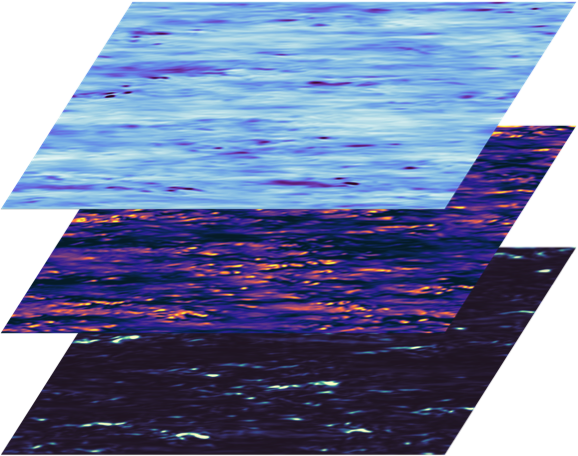Dynamics, Radiation and Chemistry coupling
The stratosphere is an important source of predictability on seasonal to subseasonal timescale for the troposphere. Processes in the stratosphere that involve the circulation coupled to radiation and chemistry are particularly important to understand and we need theoretical frameworks to understand these feedbacks.
Transport, Stirring and Mixing
The transport, stirring and mixing of tracers is relevant to many applications of fluid dynamics and exploits much interesting mathematics. I am interested in some fundamental aspects of transport, stirring and mixing, as well as implications for atmospheric chemistry and oceanic biology.
Troposphere-Stratosphere Coupling
There is much current interest on how changes to the stratosphere might affect the tropospheric circulation, or how prediction of changes to the tropospheric circulation might be limited by poor representation of the stratosphere in models. I have been investigating how dynamical sensitivity of the stratospheric circulation might allow changes imposed in the middle and upper stratosphere to penetrate downwards to the lower stratosphere and troposphere, and also how best to make quantitative predictions of the change in tropospheric circulation resulting from imposed perturbations (to the stratosphere or within the troposphere itself).
Ice shelf-ocean boundary layer
Cat Vreugdenhil, Leo Middleton, John Taylor
Ocean-driven melting of ice shelves around Antarctica has implications for rising sea levels and changing climate. We use direct numerical and large-eddy simulations to model the ocean boundary layer beneath a melting ice shelf. Fascinating phenomena includes double-diffusive convection, stratified turbulence, a buoyant plume and other instabilities. This NERC funded project is joint with collaborators at the British Antarctic Survey, who provide direct comparison with field observations. Our aims for this project are to help interpret real-world observations and improve parameterizations of ice shelf melting in ocean models.

Machine Learning
Rachel Furner, Jon Rosser, Peter Haynes
Data driven methods such as statistics, AI, and Machine Learning have long been used to enhance our understanding of the physical ocean and atmospheric dynamics, especially within modelling these systems i.e. with statistically derived model parameterisations, and the use of emulators to better understand the impact of specific variables on modelled systems and quantify the uncertainty associated with model predictions.
Recently vast improvements in compute power, availability of increasingly large datasets, and developments in the algorithms used, mean machine learning methods have lead to huge advances in a number of application areas, including the geophysical sciences.
Within the Atmosophere-Ocean dynamics group we focus on two specific areas within this field. Jon Rosser's research investigates using ML to understand causality within models, with a specific focus on the causal links driving Southern Ocean Dynamics across the CMIP5 model database. Rachel Furner's research interests are focused on using data-driven methods to directly improve the accuracy and/or efficiency of ocean models, for example through using machine learning to identifying improved parameterisations, or looking to identify more computationally-efficient data-driven analogue models.
Stratified mixing in the turbulent ocean
Chris Howland, Sam Lewin, John Taylor
Turbulent mixing in the interior of the ocean governs the vertical transport of tracers such as heat, carbon and nutrients, as well as playing an important role in closing the global overturning circulation. Simple models and parameterizations are often used to infer estimates of this mixing in both observations and large scale circulation models. We use high resolution direct numerical simulations to investigate how well the assumptions in these parameterizations hold in a range of problems including stratified shear layers, forced stratified turbulence, and breaking internal gravity waves.

Instability and mixing at ocean fronts
The atmosphere and ocean interior communicate through the ocean surface mixed layer. Turbulence acts to vertically-homogenise this upper-most layer of the ocean down to typical depths of 10 to 100 metres. The specific properties of the mixed layer determine how permeable this transport buffer is to exchanges of heat, momentum, carbon, oxygen, and other important biogeochemical tracers, and so these dynamics in the upper ocean can have an important influence on the Earth's climate system.
In particular, we focus on dynamics at the submesoscale, which can greatly enhance communication across the mixed layer. The submesoscales in the ocean range from 0.1 km to 10 km with time-scales on the order of hours to days. This range of scales falls between the small, nearly-isotropic microscale of turbulence and the Rossby deformation radius, above which motions become quasi-geostrophically balanced. In non-dimensional terms, both the Rossby and Richardson numbers are order unity so that inertial, rotational, and stratification effects are all important. Of these submesoscale features, frontal regions, or local areas with large lateral density gradients are relatively common. These lateral density gradients may be set up through frontogenetic strains by mesoscale eddies, or by coastal upwelling, intrusions into intermediate waters, or river discharges. Submesoscale fronts are particularly susceptible to symmetric instability — a form of stratified inertial instability (or "slantwise convection") which can occur when the potential vorticity is of the opposite sign to the Coriolis parameter. We are interested in how symmetric instability instigates and is coupled with large-scale inertial shear oscillations responsible for restratifying the frontal region. In particular, we are exploring the influence the front strength and finite width has on the linear and nonlinear dynamics of equilibration, and how symmetric instability may influence larger-scale motions related to baroclinic or barotropic instability.
Zonal jet dynamics
Zonal jets are persistent east-west flows that form spontaneously in planetary atmospheres and oceans. Key examples include mid-latitude jets in the troposphere and multiple jets in the antarctic circumpolar current. We use a framework of idealized models that retain the essential ingredients necessary for jet formation and equilibration in order to study aspects of zonal jet variability. Such models are of interest both because of their relevance to the behaviour of naturally occurring jet streams and for the insights they provide into the dynamical mechanisms operating in these systems.


